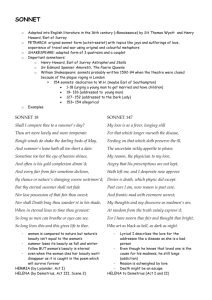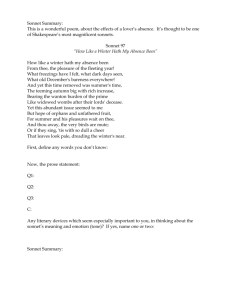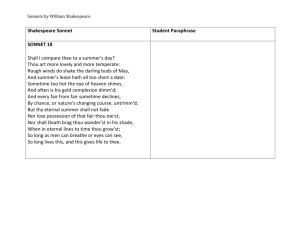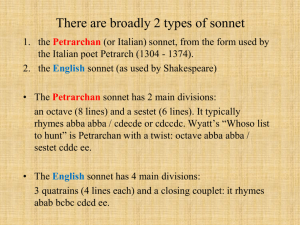Sonnet 43-Browning - Doral Academy Preparatory
advertisement
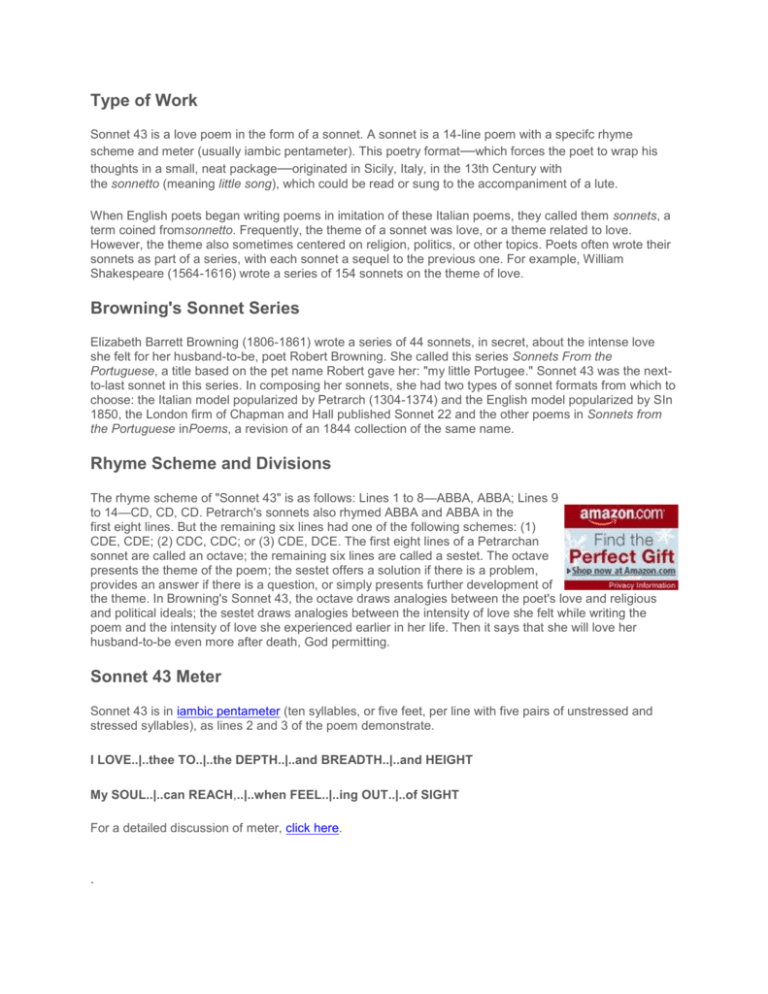
Type of Work Sonnet 43 is a love poem in the form of a sonnet. A sonnet is a 14-line poem with a specifc rhyme scheme and meter (usually iambic pentameter). This poetry format—which forces the poet to wrap his thoughts in a small, neat package—originated in Sicily, Italy, in the 13th Century with the sonnetto (meaning little song), which could be read or sung to the accompaniment of a lute. When English poets began writing poems in imitation of these Italian poems, they called them sonnets, a term coined fromsonnetto. Frequently, the theme of a sonnet was love, or a theme related to love. However, the theme also sometimes centered on religion, politics, or other topics. Poets often wrote their sonnets as part of a series, with each sonnet a sequel to the previous one. For example, William Shakespeare (1564-1616) wrote a series of 154 sonnets on the theme of love. Browning's Sonnet Series Elizabeth Barrett Browning (1806-1861) wrote a series of 44 sonnets, in secret, about the intense love she felt for her husband-to-be, poet Robert Browning. She called this series Sonnets From the Portuguese, a title based on the pet name Robert gave her: "my little Portugee." Sonnet 43 was the nextto-last sonnet in this series. In composing her sonnets, she had two types of sonnet formats from which to choose: the Italian model popularized by Petrarch (1304-1374) and the English model popularized by SIn 1850, the London firm of Chapman and Hall published Sonnet 22 and the other poems in Sonnets from the Portuguese inPoems, a revision of an 1844 collection of the same name. Rhyme Scheme and Divisions The rhyme scheme of "Sonnet 43" is as follows: Lines 1 to 8—ABBA, ABBA; Lines 9 to 14—CD, CD, CD. Petrarch's sonnets also rhymed ABBA and ABBA in the first eight lines. But the remaining six lines had one of the following schemes: (1) CDE, CDE; (2) CDC, CDC; or (3) CDE, DCE. The first eight lines of a Petrarchan sonnet are called an octave; the remaining six lines are called a sestet. The octave presents the theme of the poem; the sestet offers a solution if there is a problem, provides an answer if there is a question, or simply presents further development of the theme. In Browning's Sonnet 43, the octave draws analogies between the poet's love and religious and political ideals; the sestet draws analogies between the intensity of love she felt while writing the poem and the intensity of love she experienced earlier in her life. Then it says that she will love her husband-to-be even more after death, God permitting. Sonnet 43 Meter Sonnet 43 is in iambic pentameter (ten syllables, or five feet, per line with five pairs of unstressed and stressed syllables), as lines 2 and 3 of the poem demonstrate. I LOVE..|..thee TO..|..the DEPTH..|..and BREADTH..|..and HEIGHT My SOUL..|..can REACH,..|..when FEEL..|..ing OUT..|..of SIGHT For a detailed discussion of meter, click here. . .. Theme: Intense Love Sonnet 43 expresses the poet’s intense love for her husband-to-be, Robert Browning. So intense is her love for him, she says, that it rises to the spiritual level (lines 3 and 4). She loves him freely, without coercion; she loves him purely, without expectation of personal gain. She even loves him with an intensity of the suffering (passion: line 9) resembling that of Christ on the cross, and she loves him in the way that she loved saints as a child. Moreover, she expects to continue to love him after death. Figures of Speech The dominant figure of speech in the poem is anaphora—the use of I love thee in eight lines and I shall but love thee in the final line. This repetition builds rhythm while reinforcing the theme. Browning also uses alliteration, as the following examples illustrate: thee, the (Lines 1, 2, 5, 9, 12). thee,they (Line 8) soul, sight (Line 3) love, level (Line 5) quiet, candle-light (Line 6) freely, strive, Right (Line 7) purely, Praise (Line 8) passion, put (Line 9) my, my (Line 10) love, love (Line 11) With, with (Line 12) lost, love (Line 12) but, better (Line 14) Sonnet 43 By Elizabeth Barrett Browning Published in 1850 . Text of the Poem Annotations How do I love thee? Let me count the ways. thee: the poet's husband, Robert Browning I love thee to the depth and breadth and height depth, breadth: internal rhyme My soul can reach, when feeling out of sight For the ends of Being and ideal Grace. I love thee to the level of everyday's Most quiet need, by sun and candle-light. I love thee freely, as men strive for Right; when . . . Grace: when my soul feels its way into the spiritual realm (out of sight) to find the goal of being alive and living uprightly I love you enough to meet all of your simple needs during the day (sun) and even during the night (candle-light) freely: willingly—and just as intensely as men who fight for freedom I love thee purely, as they turn from Praise. I love thee with the passion put to use In my old griefs, and with my childhood's faith. I love thee with a love I seemed to lose With my lost saints!—I love thee with the breath, Smiles, tears, of all my life!—and, if God choose, purely: genuinely, without desire for praise with an intensity equal to that experienced during suffering or mourning; I love you with the blind faith of a child with . . . saints: with a childlike fervor for saints and holiness that I seemed to lose when I grew older. breath: echoes breadth, Line 2

